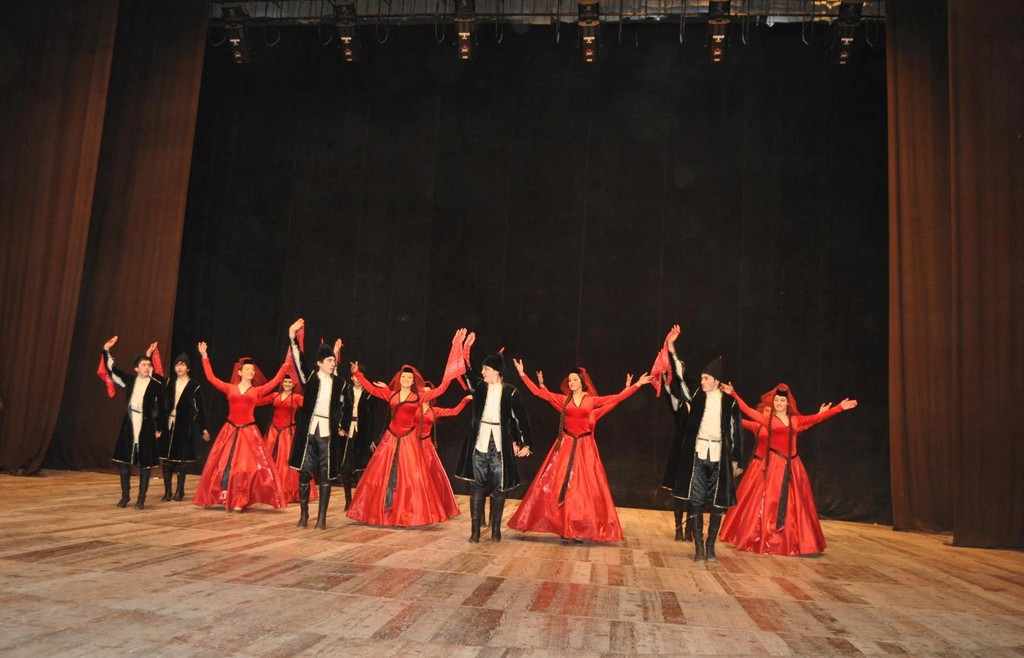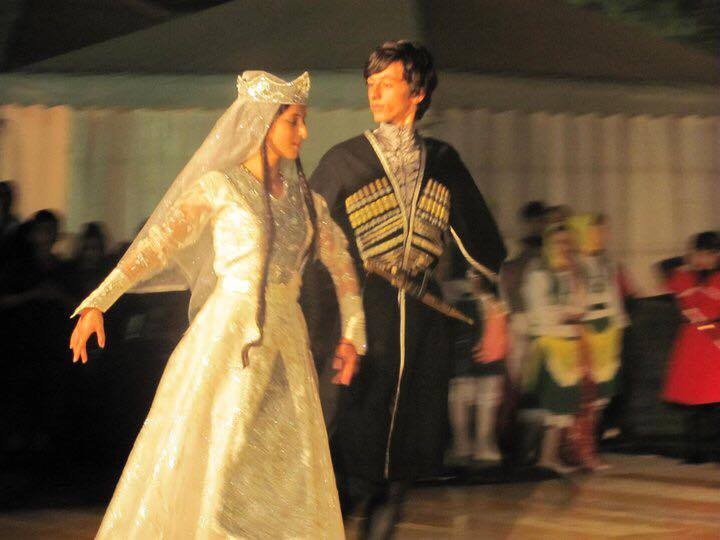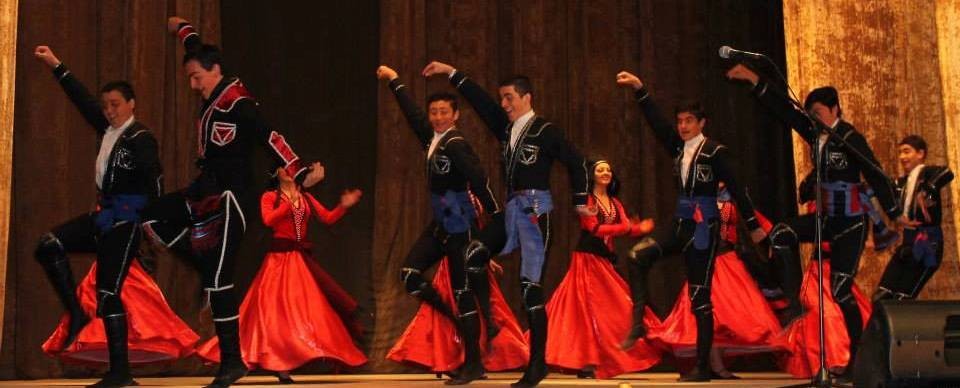Georgian folk dance

Many schoolchildren in Georgia may tell you, that after the lessons they have a dancing lesson. And you may think of some modern dances like break dance, or eastern dance, or Latin dances and stuff like that. But no, you’re wrong. They go to Georgian dances. When I went to school, half of my classmates had Georgian dance lessons after school and I had them, too. In fact, I went to Georgian dance lessons for 8 or 9 years and it was really great, I had new friends, I practiced a lot and was in a good shape, we had fun together and went on concerts, etc.
Georgia is an ancient country and has an ancient history and so does its folk dance. There are numbers of dances, all with different purposes and meanings. For what it’s worth, they are very beautiful when you watch them and you get a full pleasure doing so.
Whereas the very popular Tango or other Latin dances, Danse de Paysans, Zweifacher, Waltz, etc. requires partners to be close to each other and touch each other, there is no touching in Georgian dances. That I find very fascinating. You will be amazed, too, how these dances describe so much love and respect between man and woman, and such bravery between men fighting against each other, etc. The male dancers perform spectacular leaps and turns, incredible spins and, unlike any other dancers in the world, they dance on their toes without the aid of “block” shoes. And the women dancers glide like swans on a lake.
So, a little bit of history won’t be bad here.
Georgian choreography has a many years of history. According to the archaeological findings and written records, the ancestor for the Georgian dances is considered hunting or huntsmen’ dance. It was some kind of ritual dance in respect of the Moon God ("Shushpa"). There is a silver bowl found in excavations in Trialeti, where you can see this round dance carved on it. That bowl is dated back to 2-nd millennia BC. That is a dance of masked huntsmen and some scientists believe, that the dance might have been in respect for the Goddess Dali _ Svanetian Goddess of hunting. You can still see some huntsmen’s round dance, “Lemchili”, “Betkili round dance”, etc. in Svaneti. And this round dance was a foundation of “Khorumi”, a war dance.
There has been found a woman’s figure carved on a bone during the archaeological diggings in Bagineti. The figure is dating back to the 6-th century BC and it shows, that women made ritual dances in respect of the God of fertility, too.
Then the other dances developed along with the development of agriculture and animal husbandry. For example, there is a Kakhetian dance “Tsangala da Gogona”, which, along with the romantic plot, has elements of seeding and watering and stuff like that. Other dances were developed step by step and nowadays we have many dances with different movements in them. There are popular dance ensembles, such as Erisioni, which performs national Georgian dances and songs worldwide. There is also Sukhishvilebi _ Georgian national ballet ensemble, which have dances with the elements of Georgian dances in their performances.
- Kartuli: when we hear the name of the dance, it reminds us of a wedding, because usually it’s performed by the bride and groom at their wedding. It’s a very romantic and a very delicate dance, if you ask me. This dance is the most ancient of all the romantic Georgian dances that we know. I love that dance. And if the dancers are very good, it’s so splendid, that you’ll never get bored with watching. So, as you have already guessed, the dance is performed by a couple. The woman’s hands should move slowly and softly and her movements should be divine and full of gracefulness, and as for the man, he should be full of dignity and show respect and love to the woman. “It shows that even in love, men uphold their respect and manners by not touching the woman and maintaining a certain distance from her”. There are those small details, that make this dance even more gracious, for example, the man is constantly looking in the eyes of the woman and it’s like he doesn’t care about any other women in the world, while her eyes are always downcast, I mean, she isn’t looking up or looking at the man, and she’s kind of showing her shyness.
The woman should do this three-step movements and she should do these without spectators noticing these movements. So, she should move like a swan on a lake. She should glide. And the man does all these movements called “Gasma”, which are pretty hard if you take into account that he should be motionless at all times and just his feet and legs should move. And move very quickly! So, I don’t know if you get all that until you see the dance itself, but what I can say and everyone will agree with me, is that this dance is a very hard one to dance very well. It’s considered as one of the most difficult ones. And for these recent years, there have only been a few great performers of this dance, including Nino Ramishvili and Iliko Sukhishvili. The dance developed from a theatrical “show” or something like that from the 11-th or 12-th centuries, it was called “Sakhioba”. It was a dance with dialogues, also called “Satrpialo”, “Sadarbazo”, etc. The dance is made of five parts, but sometimes it’s just performed in four parts.

So, look at them and tell me that this is not one of the most gracious and divine things you have ever seen!
- Khorumi _ this is a dance that I’m really fond of. It’s a dance about war and how Georgian ancestors fought in battles, as they had lots of wars and battles to fight in. Khorumi originates from the region of Achara _ that is located on the southwestern part of Georgia and has beautiful seaside places, where everyone loves going in summers. So, about the dance. Personally, what I love about the dance is the exactness of movements and lines that dancers achieve. Now, in the beginning, a few men come out on the stage and they are performing those men _ the spies, who were usually sent to search the territories nearby and find out information about the enemy and stuff like that. So they come out and do moves like they are watching the territories. Then they call the others _ the army. And about 30 or 40 men come out in a line with one man leading them, and their movements are the same in the same rhythm and motion. And they have these costumes _ black clothes with red belts on waist and red belt-like things on foreheads, too, and this process is very beautiful with all these clothing and stuff. This just rises fascination in the spectators. The dance incorporates the searching, battle and the celebration of victory of the army. The celebration process is really amazing, too. The dancers show the bravery and courage that soldiers had during battles. This is a great war dance, that everyone should see and be proud of.
- Acharuli _ Acharuli also originates from the region of Achara. And that’s where it gets its name, too. The dancers wear colourful costumes and the dance has a playful and entertaining mood itself. The dancers do some beautiful movements and it’s filled with joyand that’s why the audience loves this dance so much. The dance is characterized with graceful, soft, and playful flirtation between the males and females. Unlike Kartuli, the relationship between men and women in this dance is more informal and lighthearted. It’s a happy dance, if you ask me.

- Khanjluri _ this dance involves a competition between men and how well they can handle their knives and stuff like that. This is a pretty hard dance, for in order to do those movements dancers need to practise a lot and sometimes they even get hurt while practising. I've watched my groupmates in dancing lessons practise just one movement for hours just to get it right so that when they performed it on stage they wouldn't make a mistake or something, and, hence, they wouldn't get hurt. In this dance, shepherds, dressed in red chokhas (traditional men’s wear) compete with each other in the usage of daggers and knives and in performing complicated movements. This is a great dance, which won't leave you indifferent about it.
- Samaia _ the dance Samaia means a dance of a three and it was originally performed by three women. However, the dance now inculdes more than three persons and sometimes it’s performed by 9 women and they for three small circles. The dance represents Queen Tamar of Georgia. Well, she is mentioned as the Queen of Georgia, but in fact, she was the King of the United Kingdom of Georgia in the 12-th and 13-th centuries, and so she is considered as a king. She was the first and, so far, the only woman king in the history of Georgia. The trinity idea in the dance represents King Tamar as a young princess, a wise mother and the powerful king. This is a very gracious dance and the women perform the movements very softly and beautifully. The are supposed to be divine just like the Queen Tamar was.
- Mtiuluri _ this dance is also originating from the mountainous Georgia and kind of resembles Khevsuruli. However, in this dance there is a competition between two groups of people. They compete in different difficult moves, such as dancing on toes and knees and stuff like that. Then there is a girls' dance, then there are solos of different dancers and then everyone dances a great final at the end together.

- Partsa; this dance originates from a region of Guria and is characterized by its fast pace, rhythm, festive mood, and colorfulness. As people know, people from Guria are very fast in everything, let that be dancing, talking or whatever. So, this dance is a fast dance, too, of course. During this dance, the dancer is like flying in the sky. The dancers perform such movements, that you can't even imagine. They even "build" towers by themselves and, well, this is a dance worth seeing, in short. It's an excellent combination of movements, that amaze the spectators.
- Khevsuruli; I have written about Khevsureti in my other blogs and have described it with all my heart. This is an amazing place, in the mountains of Georgia, in Caucasus. The people are great there and their special clothing have made them even greater, as their clothes differ from others and are very beautiful and the thing that they are handmade just makes you appreciate these people even more. This dance represents love, bravery, courage, competition, beauty, etc. The dance starts out with a flirting couple. Then, another young man appears, also seeking the hand of the woman. Then the fighting starts between the two men, then other men appear, too, _ the supporters of each man and then the dancers perform a fight between them and the fight stops temporarily when the woman drops her veil between the two man fighting. Traditionally, when a woman drops her head veil all the fighting stops. But then, when the woman leaves the scene, the fighting continues and it continues even more vigorously. Men attack each other with swords and perform very cool movements just like in Khanjluri or Parikaoba or something. Sometimes one man has to fight against three or four other men, etc. Then, the woman comes in and, once again, she stops the fighting with her veil. But, as you have probably guessed, the story doesn't end there and it's up to the audience's imagination what will happen next.
- Kazbeguri; This dance is performed by only men and portrays the toughness and courage of the mountain people. Kazbegi is one of the tourist attraction places, and many tourists come to Georgia just to visit it and if you love hiking and stuff, this is an excellent place for that. It's in the mountains of Caucasus, hence, the dance describes mountain men in the cold environment and how they are stiff and tough.
- Kintouri; I guess, many people just have heard about Shalakho. This is a famous dance, and very popular in Georgian weddings, I can say, and, generally, everywhere, too. The name itself “Shalakho” is Armenian, and the dance is called “Kintouri” in Georgian language. So, there were Kintos in Tbilisi _ those were people, and were merchants. They had these black silk clothes on them with silver belts on their waists, where they had this red piece of cloth. Their trousers were baggy and they wore some kind of square hats and they usually had their goods put on their heads and so they walked in the streets of Tbilisi like that. When a customer chose some goods to buy, the Kino would take the goods, wrap it in that red cloth he had in his belt and just weigh them like that. The Kintos were cunning, clever and very sociable. There are pictures of them on the river Mtkvari and gathered together on a feast, etc. There are even paintings of Niko Pirosmani_ a famous Georgian painter _ where Kintos have a feast and they have that table filled with Mtsvadi and Shoti and wine, etc. So, the dance itself is very amusing and people love to perform it. It represents how arrogant these Kintos were and always looked down on other people, while, in fact, they were just merchants.
- Simd and Khonga; Simdi is an Ossetian dance performed by many couples, unlike Khonga. There is contrast of black and white costumes in the dance, the softness of movements, the strictness of line formations, and this all makes the dance very beautiful. The dancers' costumes have very long sleeves in both dances. And the dancers' headwear are very high. Khonga or Invitation Dance _ this is Ossetian wedding dance, men dance on tiptoes, which is very difficult. Khonga is performed by a few dancers.
- Jeirani; this is a dance of a hunting scene and is performed by a woman dancer. Everyone knows Jeirani dance by Nino Ramishvili _ dancer of Sukhishvilebi National Ballet. Her gracious movements are unforgettable.
- Kharachokheli; Kharachokheli was a city craftsman, who worked very hard, wore mainly black chokha _ the national men's wear in Georgia, but he carried out this carefree life and loved wine and women and feasts. So the dance describes hislife pretty well.
- Parikaoba; this dance is from northeastern part of Khevsureti and pretty much resembles Khevsuruli. This is a dance of warriors, and there is a girl involved, of course. The girl enters looking for her beloved, while he is fighting against others and the girl drops her veil between them and the fighting stops, but when she leaves, they continue fighting (of course! ).

- Mkhedruli; so, the word "Mkhedari" means cavalryman and, hence, the Mkhedruli is, therefore, a cavalryman's dance. The dance begins in a raging tempo, becoming more and more fast and violent. The legs of the cavalryman imitate the fast movements of the horse, and the dancers' body and arm movements impersonate the battle with enemy. And just like Khanjluri, the dancers need much practice to achieve the exactness of the movements and perform the dance perfectly.
- Davluri; this is a nobles' dance. It portrays the city aristocracy. The dance kind of resembles Kartuli dance, but the "relationship" between the couples is less formal. Generally Davluri is performed by many couples, they move slowly and softly and they form rows and they go on circles and then split, and then gather together again. It's a wonderful dance. And I'm sure you all have seen those movies, where the nobles are dancing in large rooms during Balls or something. So, this dance is like that. It's like there's a Royal feast or something and the nobles are dancing there.
- Baghdaduri; this is a Georgian city-dance. It dates back to the second half of the 19-th century, and was mainly performed on a spring festival called "Keenoba". It included something like squats and jumps and pantomimic movements.

Now, after all these things that I've written here, I think you will consider watching some of the Georgian dances, because it will leave you fascinated by those movements and the elegance. I find it hard to believe, that someone seeing dancers dance real Georgian folk dances won't get an unforgettable pleasure from it. And if you see Erisioni or Sukhishvilebi dancing, this would just be perfect! They are really great at what they are doing and the movements are so exact and flawless, that it's just worth seeing!
Photo gallery
Content available in other languages
- Español: Danza popular georgiana
- Italiano: Danze folk georgiane
- Português: Dança georgiana folk
Want to have your own Erasmus blog?
If you are experiencing living abroad, you're an avid traveller or want to promote the city where you live... create your own blog and share your adventures!
I want to create my Erasmus blog! →












Comments (1 comments)
Thank you for this truly educational posting!